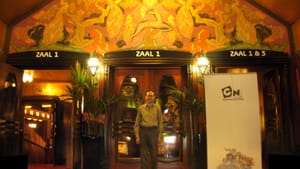Stay in the Loop
BSR publishes on a weekly schedule, with an email newsletter every Wednesday and Thursday morning. There’s no paywall, and subscribing is always free.
Howard Haas wants to save the Boyd Theater

A tiny King Kong on his desk holds Howard Haas’s business cards. Although Haas’s life involves movies, movies, movies, nothing else in his office symbolizes his passion.
Haas, the mind, spirit, and oomph of the Friends of the Boyd, spearheads the battle to save the historic Boyd Theater, 1910 Chestnut Street, from disappearing — again. Opened Christmas Day 1928, closed in 2002, the Boyd has faced a handful of wreckers — uh, developers — who want to pave paradise and put up a multiplex.
The developer du jour, iPic Theaters, a Florida company, already owns 11 theaters (three not yet open) in eight states. It promises a movie “auditorium” with pillows and, according to photos on their website, big burgers, beers, and breasts — plus a pricey Italian restaurant and “chef-prepared grab-and-go food.” You’d be able to watch vampires, Jack and Jill, or men in black while downing an $18 sandwich.
Haas believes Center City needs mainstream movie theaters more than it needs restaurants. He grew up a half block from a Philadelphia movie theater. “When you’re five,” he says, “and you see 1,500 seats, it seems huge. There was such a long lobby, you had to hike from the entrance to the main art-deco screen.”
Attending movies while relishing the architecture became Haas’s lifetime pursuit. Even today, “My primary entertainment is to go off and see a movie.”
A fateful encounter
In 1988, after college and law school, after a job in the federal government in DC, Haas moved to Academy House in Center City. He chanced upon the Sameric, formerly the Boyd, one day and was amazed. “The foyer was so grand, even in its period of decline, that I was awestruck,” he says. “I figured that since Philadelphia had built this theater, there must be others like it, but no one knew about them.” In the American Institute of Architects bookstore he found a book on Philadelphia movie theaters and learned that all of the other local movie palaces had disappeared.
Even then, a demolition sticker marred the Boyd façade. Haas began researching the salvation and reuse of other cinematic palaces. In1998, on vacation in Los Angeles, he watched flicks in lavish downtown theaters. When he encountered the Theatre Historical Society of America, he joined on the spot.
When the Sameric closed, Haas initiated triage to save the Boyd, with the avid support of film fans and historic preservationists. “It was too important not to organize a movement. I still feel that way,” he says.
The Boyd effort sometimes consumes as many hours as Haas spends practicing Social Security law. While other volunteers contribute significantly, Haas remains the towering force. Compare him to Clark Kent, a man with two lives? “That’s funny,” he says. “Clark Kent is pretty dweeby, like me. I don’t see myself as a superhero, though.”
Haas adores movie palaces, especially the “drop-dead lobby” of the Tuschinski in Amsterdam. In 2013 alone, he visited Seattle and London and spent one day touring five movie palaces in New Jersey.
Sometimes Haas feels that his life resembles the movie Groundhog Day, as he repeatedly tries to Save the Boyd.
Photo: Howard Haas in the lobby of the Tuschinski Theatre in Amsterdam, which he calls “the most dazzling daily movie palace in Europe.”
For an interview with Hamid Hashemi, the CEO of iPic, the company that wants to develop the Boyd site, click here.
For a consideration of the pros and cons of preservation by Rich Heimlich (who asks some pointed questions in the comments below), click here.
Sign up for our newsletter
All of the week's new articles, all in one place. Sign up for the free weekly BSR newsletters, and don't miss a conversation.

 Susan Perloff
Susan Perloff